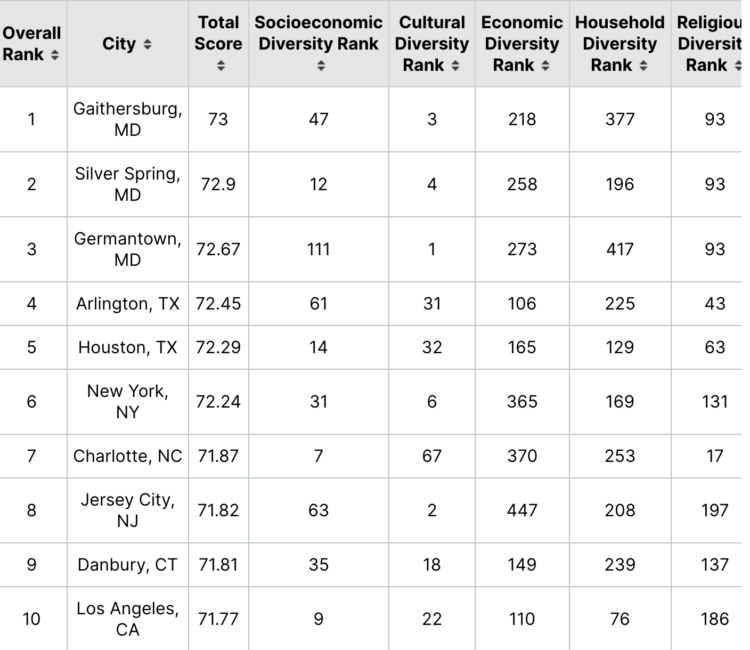
Feb. 27. America is undergoing an extreme makeover, thanks to rapid demographic diversification. For example, the percentage of people in the US who are multiracial increased from just 2.9 percent in 2010 to 10.2 percent in 2020.
Charlotte is no exception. Indeed, the Queen City ranks No. 7 on WalletHub’s list of Most Diverse US Cities, according to a new WalletHub study.

Meyers
Methodology
To determine the places in the U.S. with the most mixed demographics, WalletHub compared the profiles of more than 500 of the largest cities across five major diversity categories: socioeconomic, cultural, economic, household and religious.
Here’s a Q&A on diversity in urban life and business with Chanel Meyers Ph.D., an assistant professor at the University of Oregon.

Source: WalletHub
Q: What are the pros and cons of living and working in a diverse city?
Meyers: A growing body of research suggests the beneficial effects of racial/ethnic diversity within neighborhood, country, and state contexts. In particular, greater exposure to more diverse groups has shown to be related to more creative and flexible thinking, greater prosociality, and less experiences with discrimination. There is indeed research that shows more detrimental consequences to more diversity. For example, some research has shown that more diverse countries tend to have lower trust towards strangers and the government and lower community engagement. However, some of these findings are mixed, as other research shows that people reported more trust and engagement in more diverse communities.
Q: Is there a relationship between diversity and economic growth in cities?
Meyers: In increasingly diverse societies, people learn to adapt to interacting with people from different backgrounds. One way this might be related to economic growth is through economic interdependence. More racially diverse neighborhoods display more prosociality, which suggests that they may also be more economically dependent on one another. In other words, people rely on others (many times from different racial/ethnic backgrounds) for mutually beneficial transactions. This type of behavior should foster economic growth overall. With globalization and increased immigration in this country, social cohesion will be necessary to continue a healthy financial market.
Q: What can local policymakers do to harness the diversity in their cities to spur innovation?
Meyers: Research finds that people who are exposed to diverse groups of people adopt more creative and flexible thinking. For example, college students who worked in more racially diverse groups often exhibited more thorough information processing and complexity in their analytical thinking. Some of my research has found that when White people moved to the more racially diverse state of Hawai‘i, they demonstrated greater cognitive flexibility and less rigid thinking about social categories. Other work finds that people living in more racially diverse neighborhoods think and act more prosocially.
At a time when diversity-based policies are being dismantled, policymakers should push to retain diversity-related initiatives. An increase in diversity in the workforce, neighborhoods, and nation-level areas not only increases social progress but also intellectual and economic innovation.
Q: Which types of diversity are good or bad for cities?
Meyers: Overwhelmingly, increasing diversity in cities is a net positive. A majority of Americans say that diversity is a good thing for the country, and only a small minority report feeling negative about it. There is a plethora of research on the benefits of diversity, from feelings of inclusion and representation to intellectual and economic innovation. More often, where mixed feelings prop up is its impact on policymaking. Partisan differences about increasing diversity pose challenges for policymakers.
The downsides to diversity are often in the reactions to the increase in diversity within communities. For example, increasing racial diversity can lead to greater racial segregation. Segregated neighborhoods often have a greater impact on health outcomes, employment, and public resources/services disparities. While a state can be racially diverse if neighborhoods are segregated, that can often lead to less contact with people who are different than you, which reduces the likelihood of reaping the benefits of racial diversity. Instead, these separations often fuel negative attitudes, such as increased stereotyping and prejudice.
Q: What can local governments do to ensure health and wealth equity?
Meyers: Education about structural racism and its impact on healthcare policies is essential to tackling racial health disparities. One of the most apparent examples of this is health insurance inequities, as recent research has found that racial identity is overwhelmingly one of the most significant predictors of lack of health insurance (beyond income and health status). The Affordable Care Act was one way the government attempted to address these inequities, but Supreme Court decisions can also curtail these efforts. The government plays a prominent role in reducing health disparities across races in the U.S. However, the goal of eliminating structural racism needs to be at the forefront of policy-making if we are to make healthcare access and quality equitable.
Debunking popular myths about social change will also help lead to more diversity and equity, regarding wealth. Many “American” narratives focus on a “just world”—in other words, the notion that anyone can achieve success just by working hard. The problem with these beliefs is they ignore systemic barriers that most minorities face. Research has found that on average Americans overestimate the progress that has been made towards racial economic equality. Overwhelmingly, people believe that we have achieved considerable progress in reducing wealth disparities, but in reality, that progress is minuscule at best. For example, federal data from 2016 suggests that for every $100 in wealth that a White family has, Black families only have about $10 in wealth. The myth of social progress in America blinds us to the inequities that persist today and have impacts on minorities’ lives today.

Diversity is fine but why does it have to be forced if its so wonderful it should happen naturally. Ther alot of ethnicity that prefer to stick with their own. For example in most big cities there’s a Chinatown and Spanish neighborhoods and so on. When most minority come to USA they usually congregate in communitys of the same ethnicity because they have more incoming with people of the same background. Thats understandable but it doesn’t promote diverse neighborhoods.
I also disagree That there is inequalities against minorities. I think its more about the have and the have not there is certainly inequality based on income.
Posted by Rick | February 27, 2025, 7:00 pm